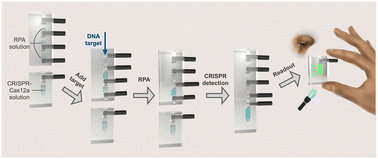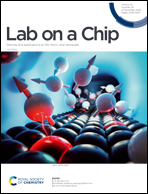Computer vision enabled funnel adapted sensing tube (FAST) for power-free and pipette-free nucleic acid detection†
Abstract
A simple, portable, and low-cost microfluidic system-funnel adapted sensing tube (FAST) is developed as an integrated, power-free, and pipette-free biosensor for viral nucleic acids. This FAST chip consists of four reaction chambers separated by carbon fiber rods, and the reagents in each chamber are transferred and mixed by manually removing the rods. Rather than using electrical heaters, only a hand warmer pouch is used for an isothermal recombinase polymerase amplification (RPA) and CRISPR–Cas12a reaction. The signal produced by the RPA–CRISPR reaction is observed by the naked eye using an inexpensive flashlight as a light source. The FAST chip is fabricated using water-soluble polyvinyl alcohol (PVA) as a sacrificial core, which is simple and environmentally friendly. Using a SARS-CoV-2 fragment as a target, a ∼10 fM (6 × 103 copies per μL) detection limit is achieved. To generalize standard optical readout for individuals without training, a linear kernel algorithm is created, showing an accuracy of ∼100% for identifying both positive and negative samples in FAST. This power-free, pipette-free, disposable, and simple device will be a promising tool for nucleic acid diagnostics in either clinics or low-resource settings.

- This article is part of the themed collections: Miniaturised Sensors & Diagnostics and Lab on a Chip HOT Articles 2022


 Please wait while we load your content...
Please wait while we load your content...
